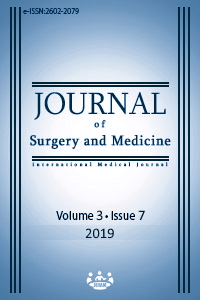Treatment of allopurinol-induced toxic epidermal necrolysis with high dose corticosteroids and intravenous immunoglobulins
Keywords:
Toxic epidermal necrolysis, SCORTEN, Allopurinol, IVIg, MethylprednisoloneAbstract
Toxic epidermal necrolysis (TEN) is an uncommon, acute and severe adverse reaction triggered by drugs, infections and malignancies. Drugs are the main cause of the disease. The most common drugs are sulfonamides and penicillins and the most often associated infectious agent is herpes simplex virus. Allopurinol is the first line drug for serum lowering therapy in gout and is approved by the US Food and Drug Administration (FDA). In recent studies, allopurinol was found to be the most commonly associated drug causing life-threatening drug reactions. Here, we aimed to present a rare case of TEN induced by allopurinol, the efficacy/harm of high dose systemic corticosteroids and use of intravenous immunoglobulins (IVIg) in the treatment of TEN
Downloads
References
Wong A, Malvestiti AA, Hafner MFS. Stevens-Johnson syndrome and toxic epidermal necrolysis: a review. Rev Assoc Med Bras. 2016;62(5):468-73.
Lee HY, Lim YL, Thirumoorthy T, Pang SM. The role of intravenous immunoglobulin in toxic epidermal necrolysis: a retrospective analysis of 64 patients managed in a specialized centre. Br J Dermatol. 2013 Dec;169(6):1304-9.
Kinoshita Y, Saeki H. A review of toxic epidermal necrolysis management in Japan. Allergol Int. 2017 Jan;66(1):36-41.
Tangamornsuksan W, Lohitnavy O, Lohitnavy M . Association of HLA-B* 5801 allele and allopurinol-induced Stevens Johnson syndrome and toxic epidermal necrolysis: a systematic review and meta-analysis. BMC Medical Genetics. 2011;12:118.
Bastuji-Garin S, Fouchard N, Bertocchi M, Roujeau JC, Revuz J, Wolkenstein P. SCORTEN: a severity-of-illness score for toxic epidermal necrolysis. J Invest Dermatol. 2000;115(2):149-53.
Kinoshita Y, Saeki H. A review of the active treatments for toxic epidermal necrolysis. J Nippon Med Sch. 2017;84(3):110-7.
Liang-ping Ye, Cheng Zhang, Qi-xing Zhu. The effect of intravenous immunoglobulin combined with corticosteroid on the progression of Stevens-Johnson syndrome and toxic epidermal necrolysis: a meta-analysis. PloS one. 2016;11(11).
Ng CY, Yeh YT, Wang CW, Hung SI, Yang CH, Chang YC, et al. Impact of the HLA-B* 58:01 allele and renal impairment on allopurinol-induced cutaneous adverse reactions. J Invest Dermatol. 2016 Jul;136(7):1373-81.
Halevy S, Ghislain PD, Mockenhaupt M, Fagot JP, Bouwes Bavinck JN, Sidoroff A et al. Allopurinol is the most common cause of Stevens-Johnson syndrome and toxic epidermal necrolysis in Europe and Israel. J Am Acad Dermatol. 2008 Jan;58(1):25-32.
Hamm RL. Drug-hypersensitivity syndrome: diagnosis and treatment. J Am Coll Clin Wound Spec. 2011;3(4):77-81.
Kumar R, Das A, Das S. Management of Stevens-Johnson syndrome – toxic epidermal necrolysis: looking beyond guidelines! Indian J Dermatol. 2018;63:117–24.
Barron SJ, Del Vecchio MT, Aronoff SC. Intravenous immunoglobulin in the treatment of Stevens-Johnson syndrome and toxic epidermal necrolysis: a meta-analysis with metaregression of observational studies. Int J Dermatol. 2015;54:108–15.
French LE, Trent JT, Kerdel FA. Use of intravenous immunoglobulin in toxic epidermal necrolysis and Stevens-Johnson syndrome: our current understanding. Int Immunopharmacol. 2006;6:543–9.
Chen J, Wang B, Zeng Y, Xu H. High-dose intravenous immunoglobulins in the treatment of Stevens-Johnson syndrome and toxic epidermal necrolysis in Chinese patients: a retrospective study of 82 cases. Eur J Dermatol. 2010;20:743–7.
Downloads
- 1357 1929
Published
Issue
Section
How to Cite
License
Copyright (c) 2019 Zeynep Gizem Kaya İslamoğlu, Mehmet Akyürek
This work is licensed under a Creative Commons Attribution-NonCommercial-NoDerivatives 4.0 International License.
















